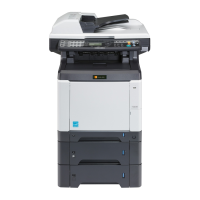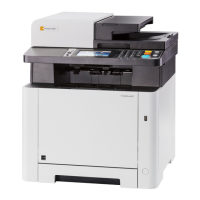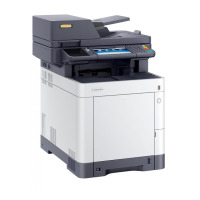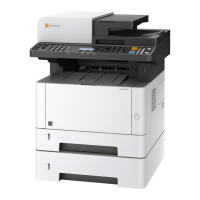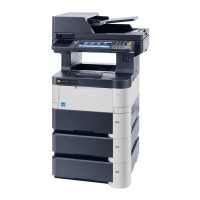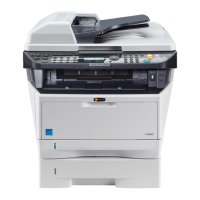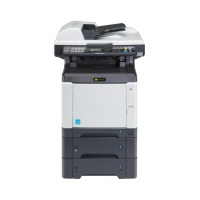
Do you have a question about the Triumph Adler P-C2660 and is the answer not in the manual?
| Functions | Print, Copy, Scan, Fax |
|---|---|
| Print Speed (Black/A4) | 26 ppm |
| Print Resolution | 1200 x 1200 dpi |
| Copy Speed (Black) | 26 cpm |
| Copy Resolution | 600 x 600 dpi |
| Fax Speed | 33.6 kbps |
| ADF Capacity | 50 sheets |
| Duplex Printing | Yes |
| Print Technology | Laser |
| Paper Size | A4, A5, A6, B5, Letter, Legal |
| Paper Capacity | 250 sheets |
| Connectivity | USB 2.0, Ethernet, Wi-Fi |
| Operating System Compatibility | Windows, Mac, Linux |
Lists the documentation provided with the machine.
Describes the controls and display of the machine's operation panel.
Illustrates and labels the main physical parts of the machine.
Verifies that all items included in the package are present.
Guides the user in selecting the appropriate connection method and preparing necessary cables.
Provides step-by-step instructions for connecting cables to the machine.
Explains the procedure for turning the machine's main power on and off.
Describes the machine's energy-saving modes to reduce power consumption.
Details how to change the display language on the machine's message display.
Guides the user on how to set the local date, time, and time difference.
Explains how to set up the machine's network connection using a LAN cable.
Provides instructions for installing necessary software on a PC from the included DVD.
Explains how to access and configure machine settings using the Embedded Web Server RX.
Describes the procedure for loading paper into the machine's cassettes and trays.
Explains how to place documents on the platen or in the document processor for scanning.
Details how to log in and log out of the machine's user management system.
Explains the functionality and usage of one-touch and program keys for quick operations.
Describes the messages and icons displayed on the machine's message display.
Guides the user through the basic steps for making copies.
Explains how to print documents from various software applications on a computer.
Covers the process of sending scanned documents via email, network folders, or FTP.
Outlines the steps needed on the PC before sending documents to it.
Describes how to confirm destination details before transmitting data.
Explains how to select or register destinations for sending functions.
Details how to perform scans using a TWAIN-compatible application.
Provides instructions on how to cancel print or send jobs.
Explains how to check the levels of remaining toner and paper in the machine.
Allows selection of the original document size for accurate scanning and copying.
Guides the user in selecting the appropriate paper source or cassette for printing.
Specifies how to set the orientation of the original document for correct scanning and printing.
A function to conserve toner by reducing print quality for non-critical documents.
Allows combining multiple originals onto a single page for copying or scanning.
Enables scanning originals in separate batches to form a single job.
Sends an email notification upon completion of a copy or send job.
Allows assigning a name and additional information to scanned files.
Enables suspending the current print job to perform an interrupt copy job.
Allows selection of the color mode (Auto, Full Color, Black & White) for copying.
Provides tools to adjust the strength of cyan, magenta, yellow, and black for fine hue adjustments.
Adjusts the sharpness of image outlines to improve clarity of originals.
Reduces dark backgrounds from originals to improve scan clarity.
Adjusts the color saturation of the image for emphasizing or softening colors.
Specifies the size of the original document used as the basis for scanning.
Selects the size of the image to be sent, which can differ from the original size.
Allows enlarging or reducing the scanned image to match the transmission size.
Selects the type and binding direction for scanning two-sided originals.
Specifies the orientation of the original document for proper readability when sending.
Selects the file format (PDF, TIFF, JPEG, etc.) for the scanned image to be sent.
Divides scanned original data into separate files page by page for sending.
Selects the image quality suited to the type of original document.
Allows adjustment of scan density for better image quality.
Selects the fineness of scanning resolution, affecting image quality and file size.
Allows selection of the color mode (Auto, Grayscale, B&W) for scanning documents.
Enables scanning multiple pages without interruption.
Allows assigning a name and additional information to scanned files.
Enables setting the subject and body text for email transmissions.
Adjusts the sharpness of image outlines for clearer scanned results.
Reduces dark backgrounds from originals to improve scan clarity.
Saves scanned images as files on a WSD-compatible computer.
Configures settings for using WSD Print functionality.
Sends an email notification upon completion of a scan or send job.
Allows encrypting documents when sending them via FTP.
Explains how to scan images using a TWAIN or WIA compatible application.
Provides instructions for printing files directly from a USB memory device.
Guides the user on how to store scanned documents onto a USB memory device.
Details the correct procedure for safely removing a USB memory device.
Explains how to print documents stored within a custom box.
Guides the user on how to print documents stored in a job box.
Displays the current status of print, send, store, and scheduled jobs.
Provides access to the history of completed jobs, including print, send, and store jobs.
Explains how to send the machine's job log history via email.
Details how to pause and resume printing or waiting jobs.
Provides instructions on how to cancel active or queued jobs.
Allows checking the status of installed devices and communication lines.
Adjusts general machine settings like language, sound, and display.
Configures default settings for copying functions, including paper selection.
Specifies default options for sending functions, including key assignments.
Configures settings related to the document box functionality, including custom boxes.
Sets default parameters for printer functions like emulation, color, and duplexing.
Configures settings for printing status reports and sending job completion notices.
Provides access to functions for adjusting print quality and performing machine maintenance.
Sets the machine's date, time, time zone, and summer time settings.
Manages destination entries in the address book and configures one-touch keys.
Explains how to restart the machine's system without turning off the main power.
Guides the user through configuring the machine's network settings, including TCP/IP and Bonjour.
Details settings for enhancing network security, including SSL and SNMPv3.
Configures settings for optional network interface kits like wireless or specific protocols.
Specifies the network interface card to be used for client functions.
Allows protection of the machine by blocking interfaces with external devices like USB.
Configures security level settings, primarily for service personnel.
Describes how to use optional applications installed on the machine.
Details procedures for cleaning the glass platen and document processor.
Explains the step-by-step process for replacing the toner container.
Guides the user on how to replace the waste toner box when it is full.
States the copyright policy regarding the reproduction of guide content.
Lists registered trademarks and product names associated with the machine and its software.
Explains the machine's low power and sleep modes for energy efficiency.
Describes the feature for performing two-sided copying to save paper.
Mentions the machine's support for recycled paper and environmental considerations.
Notes the machine's compliance with the ENERGY STAR program for energy efficiency.
Provides an overview of the operation guide's structure and content.
Explains the typographical and formatting conventions used throughout the manual.
Details the functions of each button and display on the machine's operation panel.
Provides a numbered diagram of the machine's external and internal parts.
Verifies that all items included in the package are present.
Guides the user in selecting the appropriate connection method and preparing necessary cables.
Provides step-by-step instructions for connecting cables to the machine.
Explains the procedure for turning the machine's main power on and off.
Describes the machine's low power and sleep modes to reduce power consumption.
Details how to change the display language on the machine's message display.
Guides the user on how to set the local date, time, and time difference.
Explains how to set up the machine's network connection using a LAN cable.
Provides instructions for installing necessary software on a PC from the included DVD.
Explains how to access and configure machine settings using the Embedded Web Server RX.
Describes the procedure for loading paper into the machine's cassettes and trays.
Explains how to place documents on the platen or in the document processor for scanning.
Guides the selection of paper size and media type for the main cassette.
Explains how to specify paper size and media type for the multi-purpose tray.
Details how to log in and log out of the machine's user management system.
Explains the functionality and usage of one-touch and program keys for quick operations.
Describes the messages and icons displayed on the machine's message display.
Guides the user through the basic steps for making copies.
Explains how to print documents from various software applications on a computer.
Covers the process of sending scanned documents via email, network folders, or FTP.
Outlines the steps needed on the PC before sending documents to it.
Describes how to confirm destination details before transmitting data.
Explains how to select or register destinations for sending functions.
Details how to perform scans using a TWAIN-compatible application.
Provides instructions on how to cancel print or send jobs.
Explains how to check the levels of remaining toner and paper in the machine.
Allows selection of the original document size for accurate scanning and copying.
Guides the user in selecting the appropriate paper source or cassette for printing.
Specifies how to set the orientation of the original document for correct scanning and printing.
A function to conserve toner by reducing print quality for non-critical documents.
Allows combining multiple originals onto a single page for copying or scanning.
Enables scanning originals in separate batches to form a single job.
Sends an email notification upon completion of a copy or send job.
Allows assigning a name and additional information to scanned files.
Enables suspending the current print job to perform an interrupt copy job.
Allows selection of the color mode (Auto, Full Color, Black & White) for copying.
Provides tools to adjust the strength of cyan, magenta, yellow, and black for fine hue adjustments.
Adjusts the sharpness of image outlines to improve clarity of originals.
Reduces dark backgrounds from originals to improve scan clarity.
Adjusts the color saturation of the image for emphasizing or softening colors.
Specifies the size of the original document used as the basis for scanning.
Selects the size of the image to be sent, which can differ from the original size.
Allows enlarging or reducing the scanned image to match the transmission size.
Selects the type and binding direction for scanning two-sided originals.
Specifies the orientation of the original document for proper readability when sending.
Selects the file format (PDF, TIFF, JPEG, etc.) for the scanned image to be sent.
Divides scanned original data into separate files page by page for sending.
Selects the image quality suited to the type of original document.
Allows adjustment of scan density for better image quality.
Selects the fineness of scanning resolution, affecting image quality and file size.
Allows selection of the color mode (Auto, Grayscale, B&W) for scanning documents.
Enables scanning multiple pages without interruption.
Allows assigning a name and additional information to scanned files.
Enables setting the subject and body text for email transmissions.
Adjusts the sharpness of image outlines for clearer scanned results.
Reduces dark backgrounds from originals to improve scan clarity.
Saves scanned images as files on a WSD-compatible computer.
Configures settings for using WSD Print functionality.
Sends an email notification upon completion of a scan or send job.
Allows encrypting documents when sending them via FTP.
Explains how to scan images using a TWAIN or WIA compatible application.
Provides instructions for printing files directly from a USB memory device.
Guides the user on how to store scanned documents onto a USB memory device.
Details the correct procedure for safely removing a USB memory device.
Explains how to print documents stored within a custom box.
Guides the user on how to print documents stored in a job box.
Displays the current status of print, send, store, and scheduled jobs.
Provides access to the history of completed jobs, including print, send, and store jobs.
Explains how to send the machine's job log history via email.
Details how to pause and resume printing or waiting jobs.
Provides instructions on how to cancel active or queued jobs.
Allows checking the status of installed devices and communication lines.
Adjusts general machine settings like language, sound, and display.
Configures default settings for copying functions, including paper selection.
Specifies default options for sending functions, including key assignments.
Configures settings related to the document box functionality, including custom boxes.
Sets default parameters for printer functions like emulation, color, and duplexing.
Configures settings for printing status reports and sending job completion notices.
Provides access to functions for adjusting print quality and performing machine maintenance.
Sets the machine's date, time, time zone, and summer time settings.
Manages destination entries in the address book and configures one-touch keys.
Explains how to restart the machine's system without turning off the main power.
Guides the user through configuring the machine's network settings, including TCP/IP and Bonjour.
Details settings for enhancing network security, including SSL and SNMPv3.
Configures settings for optional network interface kits like wireless or specific protocols.
Specifies the network interface card to be used for client functions.
Allows protection of the machine by blocking interfaces with external devices like USB.
Configures security level settings, primarily for service personnel.
Describes how to use optional applications installed on the machine.
Details procedures for cleaning the glass platen and document processor.
Explains the step-by-step process for replacing the toner container.
Guides the user on how to replace the waste toner box when it is full.
Provides a guide for diagnosing and resolving various machine malfunctions.
Details how to interpret and address error messages displayed on the control panel.
Provides instructions for locating and removing jammed paper from different parts of the machine.
Explains how to enable, disable, and manage user login and authentication settings.
Details how to manage copy/print counts for individual accounts to track usage.
Guides the user on how to check the total number of pages printed and scanned.
Lists and describes optional hardware components available for the machine.
Explains how to enter characters using the machine's operation panel.
Provides specifications and guidelines for using various types and sizes of paper.
Describes how to adjust the color balance of images for fine hue tuning.
Explains how to adjust the sharpness of image outlines for clearer results.
Details how to adjust the color saturation of images to emphasize or soften colors.
Lists the technical specifications of the machine, including hardware and performance.
Defines technical terms and protocols used throughout the manual.
